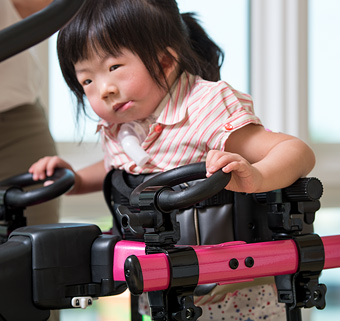Which Should I Use for Gait Training?
How to Choose Between the Rifton TRAM or the New Pacer
| May 2016 Since our newest items, the Rifton TRAM and the New Pacer both have the capacity to support walking practice and have similar prompts, including arm prompts, trunk support, and walking saddle, therapists often wonder which to choose for ambulation or gait training.
Since our newest items, the Rifton TRAM and the New Pacer both have the capacity to support walking practice and have similar prompts, including arm prompts, trunk support, and walking saddle, therapists often wonder which to choose for ambulation or gait training.
Because the TRAM does a lot more than gait training – it’s a three-in-one device that combines sit-to-sit transfer, sit-to-stand lift, and ambulation – it tends to be a first choice especially for individuals who are heavy and difficult to transfer onto a toilet or into an upright position. But for pure gait training the New Pacer offers more prompts and more functionality. It all comes down to the particular needs and abilities of the client.
 The more involved the user, the more support needed for gait practice. Some prompts are found on both the TRAM and the New Pacer, such as the arm prompts and the pelvic positioner (called a walking saddle on the TRAM). Other prompts are available on one, but not on the other, such as the New Pacer thigh prompts and ankle prompts. Yet other prompts have differences, like the trunk support. And there are further accessories that are unique to the New Pacer, such as the Multi-Position Saddle.
The more involved the user, the more support needed for gait practice. Some prompts are found on both the TRAM and the New Pacer, such as the arm prompts and the pelvic positioner (called a walking saddle on the TRAM). Other prompts are available on one, but not on the other, such as the New Pacer thigh prompts and ankle prompts. Yet other prompts have differences, like the trunk support. And there are further accessories that are unique to the New Pacer, such as the Multi-Position Saddle.
Comparison Chart
Below is a chart showing the similarities and differences of features and functions of the TRAM and New Pacer to help choose which adaptive device best fits the users needs.
| TRAM Body Support Body support system height can be effortlessly adjusted and finely tuned with the client in the device. Body support system is rigid, providing postural support. |
NEW PACER Trunk Support Chest prompt is height-adjustable. It is more effectively positionedbeforeclient is in device. Chest prompt is flexible allowing for anterior and posterior tilt adjustments for users with extensor or flexion trunk patterns during gait. |
| TRAM Frame The TRAM upper frame has no built-in dynamic movement. |
NEW PACER Upper Frame The New Pacer offers an upper frame, which has optional dynamic vertical and horizontal movement to accommodate natural movement in gait. |
| TRAM Transfer from Sit-to-Stand TRAM has a caregiver-operated up/down switch and battery-powered lift column to transition client from sitting to upright position with no lifting by the caregiver. |
NEW PACER Transfer from Sit-to-Stand With the multi-position saddle, the transition from sitting to standing is now substantially easier, but still requires physical assistance from caregiver(s). |
| TRAM Footprint Footprint is compact for greater maneuverability in confined spaces such as the home or bathrooms. Standard configuration: 27-1/2" W x 45-1/2" L Base legs expanded: 40" W x 45-1/2" L |
NEW PACER Footprint Larger footprint available with utility base to provide maximum stability and stride length during gait. Standard base: 28" W x 36" L Utility base: 32" W x 40-1/2" L |
| TRAM Lower Extremity Control No options at present to provide for lower extremity control. |
NEW PACER Thigh and Ankle Prompts Option of thigh and ankle prompts to control adducted (scissor) gait, foot placement, and stride length. |
| TRAM Weight-Bearing Components Walking saddle provides weight-bearing support during gait and standing. |
NEW PACER Weight-Bearing Components Flexible pelvic positioner provides weight-bearing support during gait and standing. Semi-rigid hip positioner with optional hip positioner pad provides weight-bearing support as well as pelvic control during gait. Solid seat multi-position saddle provides maximal weight-bearing support, plus specificity in pelvic positioning and improved ease of transfer into gait trainer. |
| TRAM Walking Saddle Dimensions The key user dimension for the Pelvic Support is half of the thigh circumference.(Sizing larger with TRAM) Small: 6"-10" Medium: 8"-14" Large: 10"-18" |
NEW PACER Pelvic Support Dimensions The key user dimension for the Pelvic Support is half of the thigh circumference. (Sizing is smaller with the New Pacer) Small: 4"-8" Medium: 6"-10" Large: 8"-14" |
| TRAM Scale TRAM has a scale that can be used to measure client's weight-bearing abilities (off-weighting). |
No scale with New Pacer. |
| TRAM Casters Full wheel locks available on two of the casters, and and optional swivel locks. |
NEW PACER Casters Standard base: Full wheel locks on all four casters, plus a drag, swivel locks and optional directional locks. Utility base: Full wheel locks on the rear wheels plus a drag, swivel locks and optional directional locks. Odometer optional on front caster for recording distance during ambulation practice. |
So ultimately, your choice comes down to the particular needs of your client. Familiarity with all the functions of both devices is key. Then let your own assessment be your guide.




